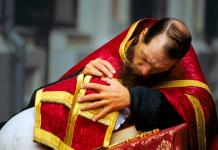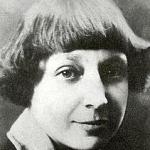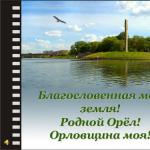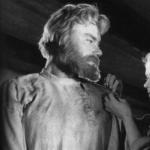Vadim DERUZHINSKY
“Analytical newspaper “Secret Research”, No. 2, 2015
Our reader from Minsk, Alexey Gennadievich Zhivitsa, writes: “Tell us about the transition in Orthodoxy from two to three fingers. There was a strong split in Muscovy on this basis. What about ON? After all, the Uniates also had the Greek rite. Please write the essence: the beginning and consequences.”
The question is really interesting and practically unstudied - for ideological and political reasons, since it is connected not only with the religion of the Old Believers, but also - most interestingly - with Moscow’s attempts to seize the Grand Duchy of Lithuania.
ESSENCE OF THE QUESTION
Let's start right away with the most important thing: today in Europe everyone is baptized incorrectly - as well as the symbolism of this act is incorrectly explained. But only Orthodox Ethiopians are baptized correctly - this is the oldest church, which directly inherited the traditions of the Jewish Christians from Israel through Egypt in the third century (700 years before the baptism of Rus'). Orthodox Ethiopians circumcise boys after birth, call biblical characters by Jewish names, keep a copy of the Ark of the Covenants in every temple, and do not recognize the Trinity, as well as the decisions of the ecumenical councils in which they refused to participate. And they cross themselves archaically, as all the first Christians did: with two fingers - the index finger is held straight and vertical, and the middle one is half-bent, the palm itself is turned perpendicular to the person, which together symbolizes the cross. That is, it’s like holding a cross in your hand. This is the whole point: they sign themselves with a CROSS OF FINGERS - and not just a set of fingers or a hand, which does not constitute a cross in any way.
All ancient Christians since apostolic times have been baptized with a finger cross. We find such images on the mosaics of Roman churches: the image of the Annunciation in the Tomb of St. Priscilla (III century), depiction of the Miraculous Fishing in the Church of St. Apollinaria (IV century), etc. But with the spread of Christianity in Europe and Asia, the original meaning was lost, and instead they began to pray simply with two fingers, which was consolidated after the fourth ecumenical council (5th century), when the dogma of two natures in Christ.
The meaning began to be completely different. Here's how the encyclopedia writes about it:
“In the double-finger fold, the thumb, little finger and ring finger are placed together, symbolizing the Holy Trinity. The middle and index fingers remain straightened and connected to each other, with the index finger held straight and the middle finger slightly bent, which symbolizes the two natures in Jesus Christ - divine and human, with the bent middle finger indicating the diminution (kenosis) of the divine nature in Christ. In contrast to the three-fingered sign of the cross of the Old Believers, the redemptive sacrifice of Jesus Christ is emphasized, therefore the words with which the sign of the cross is performed repeat the Jesus Prayer: Lord Jesus Christ, Son of God, have mercy on me a sinner.”
However, let us recall that Orthodox Ethiopians deny the Trinity and attach a completely different meaning, simply depicting a cross with their fingers. But the tradition of making the sign of the cross with straight two fingers has spread throughout the world.
Even before the baptism of Rus', in 893, two-fingered fingers were mentioned as being used by the Nestorians. This branch of Christianity was considered a heresy in Europe and was widespread in eastern countries, where all tyrants liked the fact that Nestorianism deified power and placed the ruler in the rank of “king of God.” Which to this day is reflected in the Russian Orthodox Church, which remained and remains essentially Nestorian. But the form has changed somewhat - which is due to Nikon’s reforms.
The Tatar-Mongols, who in the 1240s established their power in the Finnish Zalesie (future Muscovy), were not pagans at all, but Orthodox Nestorians. Including Batu’s son Sartak (who was blood brothers with Alexander Nevsky) was of the Nestorian faith, to which the Moscow princes willingly converted. The deification of power strengthened their positions and pleased vanity, because the flock now prayed in churches not only to frescoes with images of the kings of the Horde (who were equal to Jesus), but also to frescoes with images of their Moscow princes.
By the way, this is where the tradition of the Russian Orthodox Church arose to deify its rulers - Alexander Nevsky, Dmitry Donskoy and others, because during the time of the Nestorian Horde they were not just “saints”, but were considered “god-kings”; their frescoes were prayed to in churches as their gods.
In Horde times, a fundamental split occurred between the religion of Muscovy-Horde and the religion of Rus'. The Russian Orthodox Church in Kyiv categorically rejected the heresy of Nestorianism, accepted in Moscow since the time of Sartak (“curator” of the Finnish Zalesie, Suzdal land), and considered the Muscovites schismatics who prayed not to God, but to their Horde kings and princes.
The rulers of Muscovy did not like this at all (and their Nestorian faith was not then considered either Russian or Orthodox, or even “not Christian” at all, according to the notes of foreign travelers; only in 1589 Boris Godunov was able to persuade the Greeks to recognize the Patriarchate in Moscow and the name “Russian Orthodox Church” ", which from the baptism of Rus' belonged only to the metropolis of Kyiv - in response to which Kyiv, protesting, went to conclude a Union in 1596).
Let us recall that in 1461 the Horde-Moscow Nestorianism finally had a fight with the Greeks and declared its autocephaly, which lasted a record long time for Christianity - almost a century and a half! During this period, Muscovy and its Horde surroundings had their own autocephalous Nestorian faith - and there was a completely different faith in Rus', the faith from the baptism of Rus', the true one. Therefore, it is not surprising that Ivan the Terrible, having captured Novgorod, Pskov, Tver and Polotsk, first of all destroyed all the Orthodox clergy of the true Russian faith there (including even monks), plundered and destroyed all Orthodox churches. And he married the Novgorod bishop of the Russian Orthodox Church of Kyiv to a mare, then tied him to this mare with his face to the croup, and brought him in disgrace to Moscow, where he was hanged under the hooting of a crowd of Muscovite-Nestorians.
All this is taboo today for ideologists of the Russian Orthodox Church and historians of Russia - for obvious reasons, but just for obvious reasons, Ivan the Terrible’s hatred of Russian Orthodoxy is also clear. As Lev Gumilyov wrote, at one time alone, the Moscow despot introduced about 40 Tatar Murzas to the rank of “saints” of his autocephalous Nestorian religion - because they went over with the Tatar peoples to his service, accepting the Moscow faith. The Russian Orthodox Church of Kyiv “brazenly” refused to accept such arbitrariness - and therefore the wars of the Horde united by Ivan the Terrible against the Russian principalities were then precisely of a religious nature.
But even after the “peace” with the Greeks, who in 1589 gave Boris Godunov the patriarchate in Moscow and the very name “Russian Orthodox Church of Moscow”, these Greeks themselves were considered “disgusting infidels” in Muscovy. Their delegation was invited to celebrate the election of the first Romanov as king, but the Greeks were referred to in the papers as “non-Christians,” and after meeting with them (as well as with ambassadors from the Grand Duchy of Lithuania), the Muscovite was obliged to thoroughly wash his hands and pray so that they would not violate their “democratic filth” "Nestorian foundations of the deification of Moscow power.
Now it's time to return to the question of fingers.
HOW WE WERE BAPTIZED IN ON
Scientist Boris Uspensky in his essay “Three-fingered: the Kiev trace” writes:
“The sign of the cross was adopted in Byzantium during the baptism of Rus' and was naturally borrowed from there by the Russians. Apparently, two-fingered was replaced by three-fingered Treks in the 12th-13th centuries. Thus, historically we are talking about the opposition of the old and new Greek rite; in the actual consciousness of the era, this opposition was perceived, however, as a opposition between the Russian and Greek traditions.”
This interpretation raises great doubts, since in this “alignment of realities” the role of the Nestorian Horde is not taken into account. We should not forget the fact that in 1273, long before the wedding of Moscow Prince Ivan III with Sophia Paleologus, the ruler of the Horde Nogai married the daughter of the Byzantine Emperor Michael Paleologus - Euphrosyne Paleologus. And he accepted Orthodoxy (as well as the double-headed Byzantine eagle as the official coat of arms of the Horde).
But in any case, the historian’s conclusion is incorrect. During the period of autocephaly of Moscow, this was not at all a “contradiction between the Russian and Greek traditions,” but a contrast between the Russian tradition of the Russian Orthodox Church of Kiev (where they began to cross themselves in the Greek manner with three fingers - which is quite understandable, since the Russian Orthodox Church of Kyiv was a Greek metropolitanate) - and the Nestorian tradition of the Horde-Muscovy (where, according to the Nestorian tradition, they crossed themselves with two fingers - after all, Moscow declared itself independent from the Orthodox world and from the Greek church authorities).
There is clear evidence that Russian Orthodox Christians of the Grand Duchy of Lithuania crossed themselves with three fingers. This explains another reason for Ivan the Terrible to hate the Orthodoxy of free Rus': in Rus' they baptized with three fingers, and in Muscovy-Horde with two fingers according to the tradition of Nestorianism.
Boris Uspensky writes:
“We have at our disposal a source that allows us to make some assumptions in this regard - these are the notes of Ulrich von Richenthal, a resident of the city of Constance, about the Council of Constance of 1414-1418. A participant in this council was Metropolitan Gregory Tsamblak, who was installed on November 15, 1415 by the bishops of Lithuanian Rus' at the insistence of Grand Duke Vytautas to the metropolis of Kyiv and All Rus'.
Tsamblak arrived in Constance on February 19, 1418 and soon after his arrival - apparently on Sunday February 20 - he celebrated the liturgy here. Ulrich von Richenthal happened to be present at this service, and he left a detailed description of it; he, as a foreigner, was interested in all the details of what he saw - and he notes what a Russian observer, well acquainted with the church service, would not have noted; in particular, he describes how Tsamblak and the clergy around him were baptized.
This is what Richenthal reports: “Then on Saturday, February 19<в Констанц>the highly revered gentleman, Mr. George, Archbishop of Kiev, arrived from the land of the White Russians, which is near Smolensk. Under him<в его управлении>there are 11 bishops, and he professes the Greek faith... As soon as the Archbishop of Kiev settled in place, he ordered a throne to be built in his house, where he and his priests could serve the liturgy. This liturgy, as well as the throne, was seen by myself, Ulrich Richenthal, and by one doctor of theology, whom the archbishop allowed to attend. I asked him<доктора>so that he would take me with him, which he did."
This is followed by a description of the service, valuable for the historian of the Russian church. Here, by the way, we read: "...and each crossed himself three times, and it was like this. Each touched his forehead with three fingers of his right hand and brought his fingers down to his chest and from there to his right and left shoulder. And so they were baptized<делали крест>many times during the liturgy."
So, as far as can be understood from this description, Gregory Tsamblak and his entourage were baptized with three fingers. This is one of the earliest evidence of triplicity in Rus'. Noteworthy is the fact that this evidence refers to representatives of Lithuanian (Southwestern) Rus'. It would be tempting to conclude from this that triplicate comes to Great Russia not from Constantinople, but from Kyiv. We know that Nikon’s reforms, subjectively oriented toward the Greek Church, were objectively influenced by the church tradition of Southwestern Rus'.
...In this case, Nikon, apparently, was directly guided by the Greek church tradition.”
Alas, Boris Uspensky was not able to fully understand this issue, since he missed the main thing - the historical and political context of Nikon’s reforms.
HOW IT WAS
In the Moscow Church, double-fingering was abolished in 1653 by Patriarch Nikon; this decision was approved in 1654 by a council of bishops (except for Pavel Kolomensky).
Two important events are associated with this same date: the union of Eastern Ukraine with the Muscovy Horde and the beginning of Moscow’s war against the Grand Duchy of Lithuania-Belarus of 1654-1667, in which the tsar set his troops the goal of “There will be no Union, there will be no Latinism, there will be no Jews” and destroyed half of our population.
The main task of the Tatar-Muscovites was to convert the Rusyn-Ukrainians and Litvin-Belarusians to their Nestorian Muscovite faith, which automatically meant an oath to the “God Tsar” of Moscow (and enslaved the peasants not just into feudal slavery, but already into mental serfdom, after all, the peasant became a slave not of the feudal lord, but of “GOD”).
Faith and oath to the tsar were inseparable for the Muscovites, therefore they punished betrayal of the oath with purely religious executions - for example, they slaughtered every child in the city of Brest, impaling the bodies of those killed on stakes in ravines - so that they would be eaten by wild animals, preventing Jesus from resurrecting these dead. The population of Brest was accused of not only “betraying the oath to the Tsar,” but allegedly betraying the Nestorian faith of the Muscovites, where the Tsar is God.
But here’s the problem: in Rus' in the Grand Duchy of Lithuania everyone prays with three fingers and considers the Tatar-Muscovites schismatics for their Nestorian two-fingered fingers. And they are unlikely to submit to the task of “unifying in the Moscow faith,” since everyone in Rus' clearly knows that triplicate comes from the old traditions of the forefathers of Rus', and from Byzantium, from the Greeks, from the Russian Metropolis of the Russian Orthodox Church of Kyiv in general.
So what to do? This issue became the main one for Tsar Alexei Romanov when in 1653 he discussed with his Moscow “strategists” (including church strategists) plans for the occupation of Ukraine (Rus), Belarus (Lithuania) and Poland.
We thought for a long time, Muscovites racked their brains. As a result, we decided: in order to assimilate the “Belarusians” (this name was invented for the residents of the occupied territories who converted to the Moscow faith), let’s meet them halfway and slightly change our rituals and other things in the manner of the Russian and Greek traditions. Let us, in order not to differ from the “Belarusians,” also begin to cross ourselves with three fingers.
“We won’t fall apart because of this,” said Alexey Romanov. “But we will conquer vast spaces with such deception and force other nations to swear allegiance to me.”
- Great idea! Nikon supported. – But what if someone in our country does not want such a reform?
“Execute them,” came the answer.
This discussion of the plan to invade the Grand Duchy of Lithuania went one way or another, but essentially in this vein. And it was precisely the big military plans to seize vast western lands that became the reason for Nikon’s reform, which, without considering this main aspect, seems simply ridiculous from the outside.
In principle, it makes no difference whether you cross yourself with two fingers or three. Indeed, at the Local Council of the Russian Orthodox Church in 1971, all pre-Nikon rites of the Moscow Horde, including the two-fingered sign of the cross, were recognized as legitimate. But for Catholics, this nuance is not important at all - you can even cross yourself with your palm (and for those without arms, even with your foot). But it was then, at the beginning of the war of 1654-1667, that it had political significance for the seizure of new lands. For mimicry of the captured population of historical Rus' and the historical Russian Orthodox Church of Kyiv.
However, many in the Moscow state did not want to submit to these “incomprehensible” reforms - after all, no one explained to them the essence (“important, state, expansionist”). “Old Believers” appeared as a reality, which the authorities of Muscovy and then Russia, already under Peter, had to not only persecute, but also burn their settlements, and even engage in religious genocide. Hundreds of thousands of Old Believers fled to the Grand Duchy of Lithuania and other countries, and in the eighteenth century, from the Moscow province alone, about 10% of the population fled to the Grand Duchy of Lithuania-Belarus, many of whom were Old Believers.
By the time of the divisions of the Polish-Lithuanian Commonwealth, these fugitives from Russia (expelled from there for their Orthodoxy) made up about 6.5% of the population in Belarus, lived compactly in their Old Believers villages, mainly in Eastern Belarus (and live today). Contrary to the lies of the Russian officialdom, no one persecuted them here - it was we in the Grand Duchy of Lithuania who sheltered those Orthodox Christians who were spread rot in Russia. From there, Orthodox Christians fled to us in huge numbers - precisely because of the persecution of Orthodoxy in Russia.
And the reason is simple: in the Grand Duchy of Lithuania no one cared about how someone was baptized or, in general, who believed in what. Because we have never deified power. But in Russia, if someone makes the sign of the cross with a different set of fingers than “given by the authorities to the people,” then this is some kind of “conspirator against the tsar and the authorities.”
So, let's draw conclusions. The religion of the Muscovites adopted three fingers from the Grand Duchy of Lithuania - as part of the expected seizure of our lands in the 1654 aggression against us. But the war was lost, we had to wait until 1839, when by decree of the tsar our Uniate faith of Belarusians was liquidated.
As for how to correctly fold your fingers during baptism, only the original, from Ethiopian Orthodoxy, makes sense, where the bent middle finger creates the semblance of a cross. Moreover, this was probably important in some 3-4 centuries, or even under Nero in Rome, when either Christians were forbidden to wear crosses (as part of the persecution of Christians), or due to their poverty, not everyone could have a pectoral cross from metal
And then he put his fingers into a cross - here is your pectoral cross. As Philias Fog said in the novel by Jules Verne, “use what is at hand, and do not look for anything else.” Simple and practical... or because of their poverty, not everyone could have a metal cross. about Orthodoxy, where
Externally expressed in such a movement of the hand that it reproduces the symbolic outline of the Cross on which the Lord was crucified; at the same time, the overshadowing one expresses the inner; in Christ as the Son of God made man, the Redeemer of men; love and gratitude towards, hope for His protection from the action of fallen spirits, hope for.
For the sign of the cross, we fold the fingers of our right hand like this: we put the first three fingers (thumb, index and middle) together with their ends straight, and bend the last two (ring and little fingers) to the palm...

The first three fingers folded together express our faith in God the Father, God the Son and God the Holy Spirit as the consubstantial and inseparable Trinity, and the two fingers bent to the palm mean that the Son of God upon His incarnation, being God, became man, that is, they mean His two natures are Divine and human.
You should make the sign of the cross slowly: place it on your forehead (1), on your stomach (2), on your right shoulder (3) and then on your left (4). By lowering your right hand you can make a bow or bow to the ground.
Making the sign of the cross, we touch our fingers with three fingers folded together. forehead- to sanctify our mind, to stomach– to sanctify our inner feelings (), then to the right, then to the left shoulders- to sanctify our bodily powers.
About those who mark themselves with all five, or bow without having yet finished the cross, or wave their hand in the air or across their chest, the saint said: “The demons rejoice at that frantic waving.” On the contrary, the sign of the cross, performed correctly and slowly, with faith and reverence, frightens demons, calms sinful passions and attracts Divine grace.
Realizing our sinfulness and unworthiness before God, we, as a sign of our humility, accompany our prayer with bows. They are waist, when we bend down to the waist, and earthly, when, bowing and kneeling, we touch the ground with our heads.
“The custom of making the sign of the cross dates back to the times of the apostles” (Complete Orthodox Theological Theological Encyclopedia Dictionary, St. Petersburg. Published by P.P. Soykin, B.G., p. 1485). During this time, the sign of the cross had already deeply entered the lives of contemporary Christians. In the treatise “On the Warrior's Crown” (about 211), he writes that we protect our forehead with the sign of the cross in all circumstances of life: entering and leaving the house, dressing, lighting lamps, going to bed, sitting down for any activity .
The sign of the cross is not just part of a religious ritual. First of all, it is a great weapon. The Patericon, Patericon and Lives of Saints contain many examples that testify to the real spiritual power that the image possesses.
Already the holy apostles, by the power of the sign of the cross, performed miracles. One day, the Apostle John the Theologian found a sick man lying by the road, suffering greatly from a fever, and healed him with the sign of the cross (St. Life of the Holy Apostle and Evangelist John the Theologian. September 26).
Hello, Semeiskie (Old Believers) asked me a question: why do we, Orthodox Christians, cross ourselves with three fingers, while Jesus is depicted on icons with two?! They asked this question to their priest, but did not receive an answer. (Pauline)
Hegumen Alexy (Ermolaev), abbot of the Holy Trinity Selenginsky Monastery, answers our readers’ questions:
— We cross ourselves with three fingers in honor of the Holy Trinity, and the Lord Jesus Christ is the second Person of the Holy Trinity, and therefore why does the Lord need to fold three fingers?
By the sign of the cross we sanctify ourselves, but why should the second person of the Holy Trinity sanctify Himself, for He Himself is the source of sanctification.
The Lord in the icon blesses those who believe in Him, and His fingers are folded in such a way that they symbolize His name - Jesus Christ. The index finger is in the form of the letter “I”, the middle finger is the letter “C”, the thumb and ring finger are “X”, the little finger is the letter “C”. And it comes out - “Jesus Christ.” Orthodox priests also bless, for they do not bless themselves, but the Lord through them blesses people invisibly. The fingers on the icons of Nicholas the Wonderworker are folded in the same way, for example, for he, too, blesses not from himself, but from the Lord Jesus Christ, the Savior of the world.
It seems that the emergence of double fingers in the form in which it exists among the Old Believers arose during the difficult years of the Mongol-Tatar yoke, when many priests were killed, and some of them, less experienced, decided that they should fold their fingers when applying the sign of the cross to themselves it must be done the way it is depicted on the icons. And such a sign of the cross was widespread even until the time of Patriarch Nikon, a very educated man, who noticed the discrepancy between the folding of fingers between the Russians and the Greeks, from whom we accepted the faith at the end of the 1st millennium. The Greeks themselves were baptized with three fingers for almost a thousand years. This is what we did at the beginning, and then we adopted an erroneous view of the image of folding fingers during the sign of the cross, which was abolished by Patriarch Nikon.
We are not the Greeks, but they taught us faith. And His Holiness Patriarch Nikon took from their ancient books the image of folding fingers and restored the correct form, which had been accepted by the Church since apostolic times.
It cannot be that in the whole world the most ancient Orthodox Churches - Antioch, Alexandria, Jerusalem, Greece and others, who accepted Christianity in the very first centuries and still keep it intact, that they would make the mistake of crossing themselves with three fingers in exactly that form , as the Russian Orthodox Church does now. And Russian Old Believers, who consider themselves bearers of true Orthodoxy, forget from whom we accepted the faith and cross themselves with two fingers.
We need to look at the most ancient tradition, which has been preserved for two thousand years, and not at the mistake that crept in during the difficult years of the Mongol-Tatar yoke for Russia. We must face the truth and be baptized the way Orthodox Christians have been baptized all over the world for two thousand years.
Until 1656 in Rus', everyone was baptized with two fingers and in this the Russian Church differed from all Orthodox Churches.
In 1656, Patriarch Nikon in Moscow convened a Council of the Russian Orthodox Church, which was attended by four Eastern hierarchs:
Macarius, Patriarch of Antioch
Gabriel, Patriarch of Serbia
Gregory Metropolitan of Nicaea
Gideon, Metropolitan of All Moldavia.
The Russian clergy, numbering 40 metropolitans, archbishops and bishops, as well as archimandrites and abbots of Russian monasteries, also took part in the cathedral.
Three years before the council, Patriarch Nikon called on the Russian clergy to be baptized with three fingers, following the example of Byzantium. Discontent arose among the Russian clergy, and it was then that Patriarch Nikon decided to convene this council to resolve the question of how to be baptized correctly.
This council was preceded by the council of 1654, when he entered into a dispute with Patriarch Nikon Bishop of Kolomna Pavel. It is believed that Bishop Paul's father was Patriarch Nikon's grammar teacher.
In 1652 he was one of twelve contenders for the patriarchal throne. Nikon became Patriarch at the insistence of Tsar Alexei Mikhailovich.
On October 17, 1652, Patriarch Nikon presided over his episcopal consecration and elevated him to the Kolomna See.
Bishop Pavel defended the old Russian rituals so much that, according to Old Believer legend, this dispute ended with Nikon tearing off Pavel’s robe and beating Bishop Pavel with his own hands.
Without a Council Court (contrary to all church rules), he was deprived of his episcopal see by Nikon and exiled to the Paleostrovsky monastery. After this, Nikon wrote a slanderous letter to Patriarch Paisius I of Constantinople - allegedly he and John Neronov composed new prayers and church rites, and were corrupting people, and were separating from the cathedral church. The misled Patriarch of Constantinople condemned the “supporters of innovation.” Bishop Pavel was exiled by Nikon to Lake Onega, to the Paleostrovsky Nativity Monastery, where he stayed for a year and a half. The conditions of detention were quite difficult, but the saint and confessor had the opportunity to communicate with the laity and priests who flocked to him, receiving advice, consolation and archpastoral blessing from him.
According to Old Believer sources, Nikon allegedly sent hired killers, and Bishop Pavel Kolomna was burned in the log house on Great Thursday, that is, April 3, old style (13 new style), 1656.
Among the followers of the Old Rite, the veneration of Bishop Paul as a saint began immediately after his death and continues to this day.
To continue his reform, Patriarch Nikon decided to enlist the support of the eastern hierarchs, and for this purpose a council was convened in 1656.
At the council, Patriarch Nikon asked the four eastern hierarchs about how to be baptized, with two or three fingers; Patriarch Macarius of Antioch answered him:
==
The tradition is that we first received the faith from the holy apostles, and the holy fathers, and the holy seven councils, to create the sign of the honorable cross, with three fingers on the right hand, and whoever from Orthodox Christians does not create the cross, according to the tradition of the Eastern Church, holding it from the beginning of faith even to today, there is a heretic and imitator of the Armenians, and this imam is excommunicated from the Father and the Son and the Holy Spirit and is cursed==
This answer became the decision of the council; all other hierarchs signed it.
In the same year, during Great Lent, the anathema of two fingers was proclaimed in churches on the Sunday of the Triumph of Orthodoxy. The decisions of the council were published in the book “Tablet”, which was adopted at the council.
The decision of the council of 1656 to curse all those baptized with double fingers was confirmed at the Great Moscow Council of 1666-1667, at which a similar anathema was adopted not only for double fingers, but also for all old rituals and those who use them.
The anathemas of the councils of 1656 and the Great Moscow Council of 1666-1667 became the main reasons for the split of the 17th century of the Russian Church into Old Believers and New Believers.
The issue of finger placement was one of the reasons for the split.
At the Local Council of the Russian Orthodox Church on May 31, 1971, all decisions of the councils of the 17th century, including the decision of the council of 1656, against the old rituals were canceled:
==
To approve the resolution ... on the abolition of the oaths of the Moscow Council of 1656 and the Great Moscow Council of 1667, imposed by them on the old Russian rituals and on the Orthodox Christians who adhere to them, and to consider these oaths as not having been==
SO DOUBLE OR CINDED?
DOUBLE - common in medieval Orthodoxy (the Church in the East) and to this day among Old Believers, the folding of the fingers (fingers) of the right hand to make the sign of the cross. Double-fingering became commonly used in the Greek East in the 8th century (instead of the most common in ancient times and known from patristic evidence, the form of double-fingering - single-fingering.
It was supplanted by TRAP - in the 13th century among the Greeks. and in the 1650s in the Moscow Patriarchate in the Russian State (see Split of the Russian Church). The Old Believers continued to insist on two fingers on the grounds that Jesus Christ, and not the entire Trinity, suffered the death of the cross through crucifixion. In addition, the Old Believers pointed to existing images - icons, miniatures, where there were saints making the sign of the cross with two fingers.
In double-finger flexion, the thumb, little finger, and ring finger are folded together; each finger symbolizes one of the three hypostases of God: Father, Son and Holy Spirit; and their combination is one Divinity - the Holy Trinity.
In double fingers, two fingers are a symbolic expression of the dogma of the Council of Chalcedon, depicting the two natures of Jesus Christ. The middle and index fingers remain straightened and connected to each other, while the index finger is held straight, and the middle one is slightly bent in relation to the index finger, which symbolizes the two natures in Jesus Christ - divine and human, and the bent middle finger indicates the diminution (kenosis) of the divine nature in Christ.
Along with double-fingering, according to modern Old Believers, came the custom of raising the hand to the forehead, lowering it to the stomach and then moving it to the right and then to the left shoulder. The movement of the hand from the forehead to the stomach symbolizes the descent of the Lord to earth; the hand on the belly shows the incarnation of Christ; raising the hand from the stomach to the right shoulder depicts the Ascension of the Lord, and placing the hand on the left shoulder represents the reunion of Christ with God the Father.
There is no documentary information earlier than the 4th century about what type of finger was used in the early Christian era to draw the sign of the cross, but based on indirect information it is believed that one finger was used to make the sign of the cross.
We find images of double fingers on the mosaics of Roman churches: the image of the Annunciation in the Tomb of St. Priscilla (III century), depiction of the Miraculous Fishing in the Church of St. Apollinaria (IV century), etc. However, some historians, starting with Evgeniy Golubinsky, consider the ancient images of double fingers not to be a sign of the cross, but one of the oratorical gestures.
Double-fingering when making the sign of the cross, according to Russian researchers of the 19th - early 20th centuries, was consolidated after the Fourth Ecumenical Council (5th century), when the dogma of two natures in Christ was expressed - as a counter-argument against Monophysitism.
At the end of the 10th century, the Kiev prince Vladimir, at the Baptism of Rus', adopted double-fingered, which at that time was in general use among the Greeks. Three-fingeredness, later adopted by the Greeks “by custom,” did not become widespread in Muscovite Rus'; Moreover, double-fingering - as the only correct finger formation - was directly prescribed in the Moscow Church in the first half of the 16th century, first by Metropolitan Daniel, and then by the Council of the Stoglavy:
==
At the beginning of the 17th century, the doctrine that it is necessary to be baptized with two fingers was set out by the first Patriarch of Moscow and All Rus' Job in a letter to the Georgian Metropolitan Nicholas:
==«
In the Russian Church, double-fingering was abolished in 1653 by Patriarch Nikon.
On February 24, 1656, on the Sunday of Orthodoxy, Patriarch Macarius of Antioch, Patriarch Gabriel of Serbia and Metropolitan Gregory solemnly cursed those who were marked with two fingers in the Assumption Cathedral.
In polemics with the Old Believers, the Orthodox called double-fingering an invention of Moscow scribes of the 15th century, as well as a Latin or Armenian borrowing. Seraphim of Sarov criticized double-fingering as contrary to the holy statutes!
Dual-fingering was approved for use at the end of the 18th century in the Russian Church as oikonomia, when Edinoverie was introduced. At the Local Council of the Russian Orthodox Church in 1971, all pre-Nikon Russian rites, including the two-fingered sign of the cross, were recognized as “equally honorable and equally saving.”
Thus, the Russian Orthodox Church in Soviet times abolished the same decrees for non-compliance with which Bishop Paul and Archpriest Avvakum were burned, and thereby separating itself from the Ecumenical fullness of Orthodoxy, where the two-fingered addition at baptism is unacceptable.


















